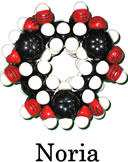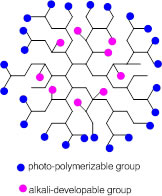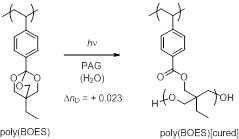Research
1. Dynamic Covalent Chemistry System

A new dynamic covalent chemistry (DCC) system in the reaction of resorcinol and 1,5-pentanedial could be achieved, yielding a only soluble oligomer noria (noria means water wheel in Latin) in high yield, resembling a water-wheel in appearance. Application of the noria derivatives with pendant photo-reactive groups were examined for UV-curing materials and photo-resist materials. The obtained noria derivatives had good solubility, good film-forming ability, high thermal stability, and high photo-chemical reactivity. Furthermore, certain new ladder cyclic oligomers could be synthesized using a similar approach to that employed for the synthesis of noria and their application as next generation resist materials was also investigated.
2. Ring-expansion polymerization for cyclic polymers
The development of synthetic process for well-defined cyclic polymers has more attractive attention for advancement of polymer chemistry. There are two well-known strategies for synthesizing cyclic polymers. One is the ring-closure reaction of linear compounds containing two reactive groups at the ends, and the other is the ring-expansion polymerization of cyclic compounds. We presented a ring-expansion polymerization of cyclic thioesters using quaternary onium salts as catalysts for the synthesis of cyclic polymers. Both intra- and inter-molecular reactions proceeded between the thioester moieties to give various sizes of macrocycles. We also succeeded the synthesis of new cyclic polymers with controlled molecular weight by the continuous insertion reaction of thiirane into cyclic thiourethane.

3. Synthesis of functional hyperbranched polymers

Synthesis and properties of alkaline-developable hyperbranched polymers containing both methacryloyl groups and carboxyl groups were examined. The synthesized photo-functional hyperbranched polymers showed high photo-chemical reactivities, fine solubility, good film-forming properties, and good thermal properties. These indicated that hyperbranched polymers with terminal photo-polymerizable groups were applicable to new UV curing materials. Furthermore, the cured films obtained from the photo-functional hyperbranched polymers had high tensile strength and lower birefringence compared to linear ones. The negative resist composed of photo-functional hyperbranched polymers also showed better resolution.
4. Synthesis of high- and low-refractive index materials
Tellurium is one of the chalcogens, which form the 16th group in the periodic table; the other members are oxygen, sulfur, selenium, and polonium. Except for oxygen, the chalcogens have rather similar characteristics, i.e., they have similar Allred-Rochow electronegativity, ionization energy, and electron affinity. We have achieved the first synthesis of poly(phenylene telluride) by taking advantage of a novel condensation reaction of 1,3-DMB and TeCl4. This reaction proceeded at a feed ratio of 1,3-DMB/ TeCl4 = 1/ 10 without catalyst in 1,4-dioxane at 60 oC for 48 h, affording poly(1,3-DMB-co-Te) with Mn = 45,100 and Mw/Mn = 1.89 in 75% yield. The 1H NMR, IR, and X-ray fluorescence spectroscopy results indicated that poly(1,3-DMB-co-Te) has a branched skeleton in part. Poly(1,3-DMB-co-Te) showed good solubility, good film-forming ability, and high thermal stability. The refractive index value of its thin film (0.1 μm) was 1.769, as measured by ellipsometry at 0.6328 μm. Poly(1,3-DMB-co-Te) seems to be a promising candidate for application in the field of optoelectronics in the future.

5. Synthesis of refractive-index change materials
Refractive-index-changing materials are required for write-read-erase recording, switching devices, optical waveguides, memories, and holographic image recording. Nishikubo et al.14, 15, 16, 17 reported that polymers containing certain norbornadiene (NBD) moieties in the main and side chains showed high photochemical reactivity, and had a high photo-energy storage capability. Furthermore, materials which show a refractive index increase after photo-irradiation have been reported by several researchers. The thin films of polymer with pendant bicyclo ortho ester groups were prepared, and their photochemical reaction and refractive-index changes were examined. The refractive index (ηD) increased by between +0.011 and +0.023 upon photo-irradiation.



